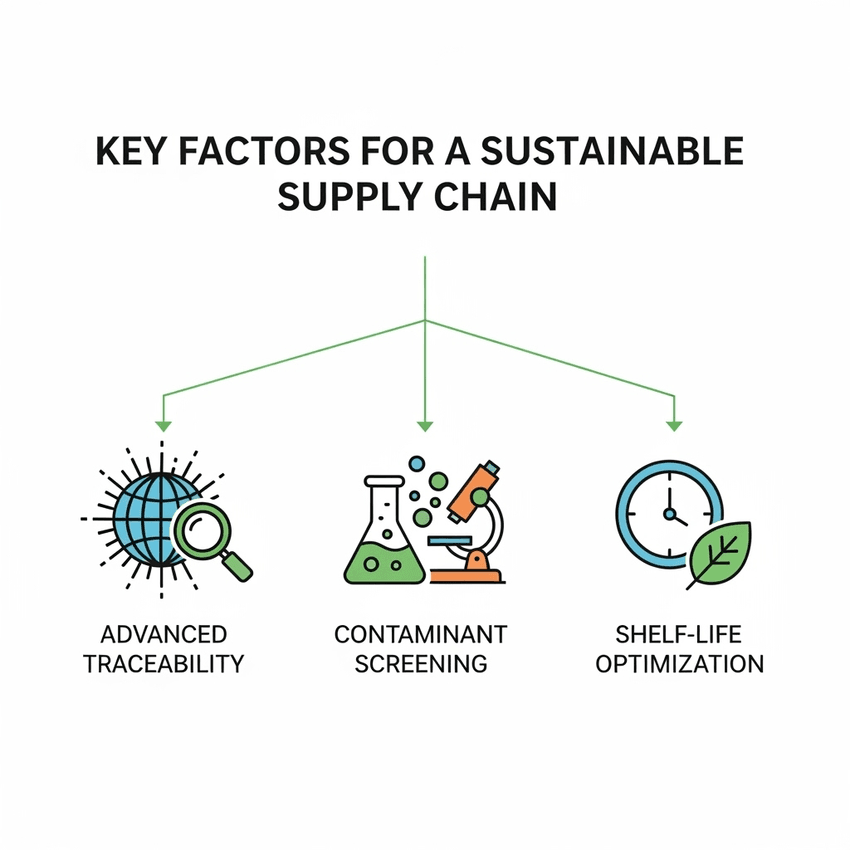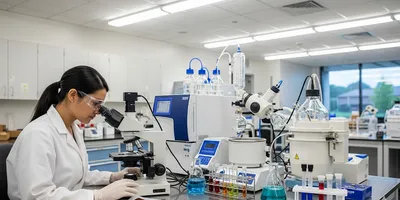The traditional linear "take, make, dispose" model of food production is no longer tenable in the face of global resource constraints, climate change, and consumer demand for ethical sourcing. As an alternative, a circular economy for food and beverage (F&B) is emerging as a powerful framework to address these challenges. This model, centered on minimizing waste and maximizing the value of resources, requires a fundamental shift in how food is produced, processed, and consumed. At the forefront of this transformation is the modern laboratory, where scientific expertise is applied to every stage of the food value chain, from raw material sourcing to the valorization of by-products. For laboratory professionals, understanding and implementing the principles of a circular economy in F&B is not merely a trend but an essential contribution to building truly sustainable food systems. This article explores the scientific and technical methodologies employed in the lab to drive this critical shift, highlighting actionable strategies for waste reduction, resource recovery, and enhanced sustainability.
Lab-Driven Strategies for a Circular Economy in F&B
The transition from a linear to a circular model in the F&B industry is underpinned by three core principles: designing out waste and pollution, keeping products and materials in use, and regenerating natural systems. The laboratory serves as the engine room for all three principles. It is here that waste streams are analyzed, new valorization processes are developed, and material properties are optimized for reuse. The work of laboratory professionals is therefore central to creating the closed-loop systems that define a circular economy in F&B. This requires a holistic approach, moving beyond simple disposal to viewing every by-product as a potential resource.
- Waste Stream Characterization: The first step in valorization is to thoroughly analyze the waste streams generated during food processing. Techniques such as proximate analysis, chromatography, and mass spectrometry are used to identify and quantify the composition of waste materials, including proteins, fibers, lipids, and bioactive compounds. For instance, whey from cheese production is a rich source of proteins and lactose, while pomace from fruit juice manufacturing contains valuable fibers and antioxidants.
- By-product Valorization: Labs are instrumental in developing processes to extract and transform these valuable components. This could involve physical separation, chemical hydrolysis, or biological conversion methods. The resulting ingredients can then be used in new food products, animal feed, or even non-food applications.
- Process Optimization: The lab also plays a crucial role in optimizing existing manufacturing processes to reduce waste at the source. This can involve implementing more efficient extraction techniques, improving product yield through better process control, and developing formulations that require fewer raw materials.
By integrating these strategies, laboratories can transform the financial and environmental ledger of a company, turning what was once a liability—waste—into a valuable asset. The work on sustainable food systems starts here, at the microscopic level of waste analysis and molecular extraction.
From Waste to Resource: Innovative Lab Technologies
The concept of "valorization" is the cornerstone of a circular economy in F&B, and it is brought to life through a suite of advanced lab technologies. These methods enable the extraction and repurposing of valuable compounds from what would otherwise be considered food waste. This not only reduces the volume of landfill waste but also creates new revenue streams and enhances the overall sustainability profile of food production.
- Enzymatic Hydrolysis: Many food processing by-products, such as grain husks or fruit peels, are rich in complex polymers like cellulose and pectin. In a lab setting, specific enzymes are used to break down these materials into simpler sugars, which can then be fermented to produce biofuels, bioplastics, or single-cell proteins. This controlled, biological process is highly efficient and minimizes the use of harsh chemicals.
- Supercritical Fluid Extraction (SFE): For extracting high-value compounds like essential oils, flavors, or antioxidants from plant-based by-products, SFE is a clean and effective method. Using a solvent such as carbon dioxide in its supercritical state, labs can selectively extract target compounds without leaving behind harmful residues. This method is particularly useful for valorizing spent coffee grounds or citrus peels.
- Precision Fermentation: This groundbreaking technology allows for the precise production of specific ingredients—such as vitamins, pigments, or novel fats—using microorganisms. Instead of relying on traditional agricultural sources, labs can design and cultivate microbes to produce these compounds in a highly controlled bioreactor. This reduces the environmental impact associated with conventional farming and ensures a consistent, high-purity product.
- Membrane Filtration: Techniques like microfiltration, ultrafiltration, and nanofiltration are used to separate and concentrate components in liquid waste streams. For instance, in the dairy industry, these methods are used to recover proteins from whey, enabling its transformation into high-value protein powders.
These technologies exemplify how laboratory innovation is moving beyond quality control to actively design and build sustainable food systems from the ground up.
Lab-Based Quality and Safety for Sustainable Supply Chains
The pursuit of sustainable food systems extends far beyond waste management; it also involves ensuring the integrity and efficiency of the entire supply chain. Here, analytical labs play a critical role in verifying the authenticity, safety, and quality of food products, thereby reducing waste from recalls and ensuring consumer trust. This approach contributes directly to a circular economy in F&B by preventing resource loss due to spoiled or contaminated goods.

These factors are improving the sustainability of food and beverages on a global scale.
GEMINI (2025)
- Advanced Traceability: Lab professionals use sophisticated analytical methods to ensure the integrity of the supply chain. For example, isotopic ratio mass spectrometry can determine the geographic origin of a food product, and DNA barcoding can verify species identification. This helps prevent food fraud and ensures that products are sourced from sustainable and ethical producers.
- Contaminant Screening: Rigorous testing for pesticides, heavy metals, and mycotoxins is a non-negotiable part of food safety. Techniques like gas chromatography-mass spectrometry (GC-MS) and inductively coupled plasma mass spectrometry (ICP-MS) provide highly sensitive and accurate detection, preventing contaminated products from entering the market and causing waste.
- Shelf-Life Optimization: By studying microbial growth and chemical degradation, labs can develop effective, natural preservation methods and optimized packaging solutions. This work directly combats food spoilage, a major contributor to food waste globally. For instance, labs can evaluate the efficacy of antimicrobial coatings or the impact of different oxygen permeability rates in packaging materials.
The lab’s work in quality assurance is an invisible but essential part of creating a circular economy, ensuring that products are not only safe and high-quality but also that the resources used to create them are not lost due to preventable issues.
Driving the Future of Sustainable Food Systems
The transformation of the food and beverage industry toward a circular economy is not a distant goal but a current reality, propelled by the scientific expertise of laboratory professionals. The transition from a linear, wasteful model to a closed-loop system of resource recovery and regeneration is a complex challenge, but the solutions are being developed every day within labs across the globe. By characterizing waste streams, developing innovative valorization technologies, and ensuring the safety and integrity of the supply chain, the laboratory is at the very heart of creating truly sustainable food systems. The ongoing work in this field will be instrumental in not only addressing environmental concerns but also in building a more resilient, efficient, and profitable food industry for future generations.
Frequently Asked Questions on Sustainable Food Systems
What is the primary difference between a linear and a circular food system?
A linear food system follows a "take, make, dispose" model, where resources are used to create a product that is then discarded after use. In contrast, a circular economy in F&B is designed to keep resources in use for as long as possible, minimizing waste and regenerating natural systems.
Advanced Lab Management Certificate
The Advanced Lab Management certificate is more than training—it’s a professional advantage.
Gain critical skills and IACET-approved CEUs that make a measurable difference.
How does laboratory waste stream analysis support the circular economy?
By analyzing waste streams, laboratories identify valuable components (e.g., proteins, fibers, antioxidants) that can be extracted and repurposed. This process, known as valorization, turns what was once a liability into a profitable resource, directly contributing to a circular economy in F&B.
What are some practical examples of food waste valorization?
Practical examples include the extraction of pectin from citrus peels for use in gelling agents, the use of spent grains from breweries to create alternative flours, and the fermentation of whey from cheese production to produce bioplastics.
Why is shelf-life optimization an important part of sustainable food systems?
Shelf-life optimization is a critical strategy for reducing food waste. By extending the freshness and safety of products through lab-developed preservation techniques and packaging solutions, less food is discarded by retailers and consumers, thereby conserving the resources used to produce and transport it.












